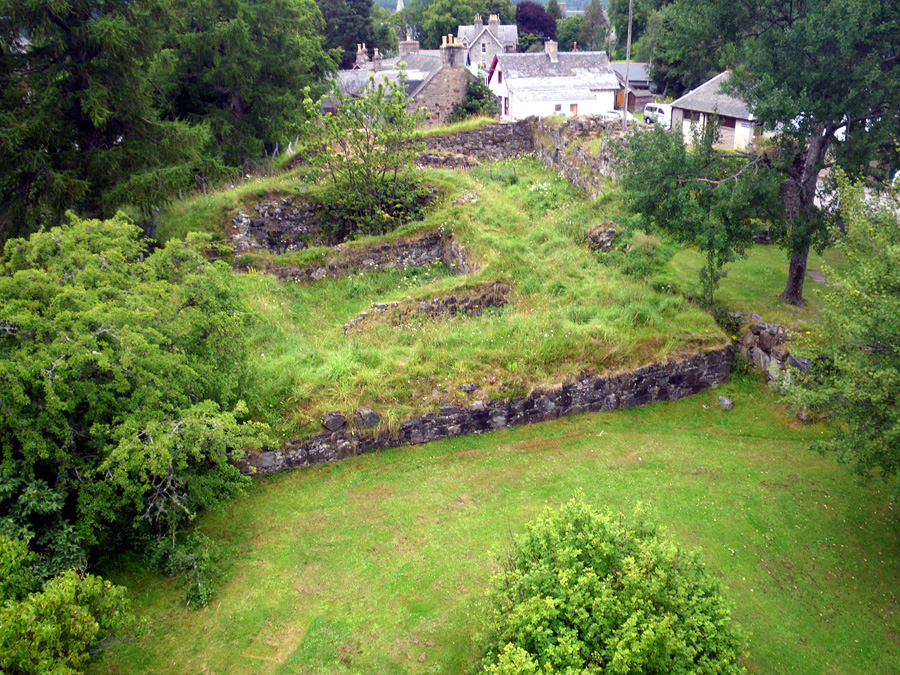Kindrochit Castle on:
[Wikipedia]
[Google]
[Amazon]
 Kindrochit Castle () is a ruined 14th-century fortification in
Kindrochit Castle () is a ruined 14th-century fortification in C. Michael Hogan, ''Elsick Mounth'', Megalithic Portal, editor: Andy Burnham (2007)
/ref>
 Kindrochit Castle () is a ruined 14th-century fortification in
Kindrochit Castle () is a ruined 14th-century fortification in Aberdeenshire
Aberdeenshire ( sco, Aiberdeenshire; gd, Siorrachd Obar Dheathain) is one of the 32 council areas of Scotland.
It takes its name from the County of Aberdeen which has substantially different boundaries. The Aberdeenshire Council area incl ...
, Scotland
Scotland (, ) is a country that is part of the United Kingdom. Covering the northern third of the island of Great Britain, mainland Scotland has a border with England to the southeast and is otherwise surrounded by the Atlantic Ocean to th ...
. It is located at Braemar
Braemar is a village in Aberdeenshire, Scotland, around west of Aberdeen in the Highlands. It is the closest significantly-sized settlement to the upper course of the River Dee sitting at an elevation of .
The Gaelic ''Bràigh Mhàrr'' pr ...
, in a strategic position on the banks of the Clunie Water
Clunie Water is a river of Aberdeenshire, Scotland. It is a tributary of the River Dee, joining the river at Braemar, among grey stone buildings. Callater Burn is a tributary of the Clunie; the confluence is at Auchallater. The river flows alo ...
, a tributary of the River Dee. The ruins are protected as a scheduled monument
In the United Kingdom, a scheduled monument is a nationally important archaeological site or historic building, given protection against unauthorised change.
The various pieces of legislation that legally protect heritage assets from damage and d ...
.
Kindrochit was a hunting seat of King Robert II, who issued charters here most years between 1371 and 1388. In 1390 Robert III granted a licence to Malcolm Drummond to build a new tower on the site. The present ruins comprise the ground floor of the tower, measuring around . The site of the earlier royal lodge was excavated in the 1920s and included a hall around , with square towers at each corner.
John Erskine, Earl of Mar showed the ruined castle at Kindrochit to John Taylor John Taylor, Johnny Taylor or similar may refer to:
Academics
*John Taylor (Oxford), Vice-Chancellor of Oxford University, 1486–1487
*John Taylor (classical scholar) (1704–1766), English classical scholar
*John Taylor (English publisher) (178 ...
when the poet made his ''Pennyles Pilgrimage'' to Scotland in 1618. Taylor, who rode with the Earl from Braemar Castle
Braemar Castle is situated near the village of Braemar in Aberdeenshire, Scotland. It is a possession of the chief of Clan Farquharson and is leased to a local charitable foundation. It is open to the public.
History
From the Late Middle Ages, ...
, was told that Malcolm Canmore
Malcolm III ( mga, Máel Coluim mac Donnchada, label= Medieval Gaelic; gd, Maol Chaluim mac Dhonnchaidh; died 13 November 1093) was King of Scotland from 1058 to 1093. He was later nicknamed "Canmore" ("ceann mòr", Gaelic, literally "big head ...
had built the castle in the 11th century. He thought it remarkable because he did not see another house in the next 12 days of their ride.
C. Michael Hogan has suggested that Kindrochit Castle, as well as Kildrummy
Kildrummy ( gd, Cionn Droma) is a hamlet in Aberdeenshire, Scotland near the River Don, west of Alford. The hamlet's primary school closed in 2003.
Its church was built in 1805. Nearby Kildrummy Castle has a long history dating back to at lea ...
and Durris Castle
Durris Castle or the House of Dores was an early royal residence on the southern bank of the River Dee in Aberdeenshire, Scotland. The castle controlled the northern end of the Crynes Corse Mounth trackway.
Dating from at least the 13th centur ...
s, were likely sited based upon strategic positions relative to the ancient Elsick Mounth
The Elsick Mounth is an ancient trackway crossing the Grampian Mountains in the vicinity of Netherley, Scotland. This trackway was one of the few means of traversing the Grampian Mounth area in prehistoric and medieval times. The highest pass ...
trackway
Historic roads (historic trails in USA and Canada) are paths or routes that have historical importance due to their use over a period of time. Examples exist from prehistoric times until the early 20th century. They include ancient trackways ...
, which provided a strategic crossing of the Mounth
The Mounth ( ) is the broad upland in northeast Scotland between the Highland Boundary and the River Dee, at the eastern end of the Grampians.
Name and etymology
The name ''Mounth'' is ultimately of Pictish origin. The name is derived from ' ...
of the Grampian Mountains
The Grampian Mountains (''Am Monadh'' in Gaelic) is one of the three major mountain ranges in Scotland, that together occupy about half of Scotland. The other two ranges are the Northwest Highlands and the Southern Uplands. The Grampian range ...
./ref>
References
{{coord, 57, 0, 16, N, 3, 23, 51, W, region:GB_type:landmark, display=title Castles in Aberdeenshire Ruined castles in Aberdeenshire Scheduled Ancient Monuments in Aberdeenshire